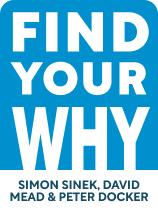

This article is an excerpt from the Shortform book guide to "Find Your Why" by Simon Sinek, David Mead, Peter Docker. Shortform has the world's best summaries and analyses of books you should be reading.
Like this article? Sign up for a free trial here .
What are the most important characteristics of a good purpose statement? How do you write a purpose statement?
Motivational speaker and author Simon Sinek believes finding your purpose helps you make more persuasive appeals to people. Your energy and commitment to your purpose are contagious, so having clarity on it helps you pitch your ideas in a way that’s more authentic and enticing to others.
Read on to learn Sinek’s proven steps for writing a good purpose statement and how to start creating your own.
Your Purpose Statement
According to Simon Sinek, a good purpose statement is a single sentence that declares your ultimate goal and vision. According to Sinek, it has two parts: The first part should spell out the core action your Why compels you to take. The second part should state what you’re ultimately striving to achieve: the impact you want to have.
An older version of Airbnb’s mission statement is a great example of a purpose statement: To connect millions of people in real life all over the world, through a community marketplace (core action)—so that you can Belong Anywhere (impact).
(Shortform note: In First Things First, Stephen Covey also suggests writing a statement of what matters most to you and what you hope to achieve, but he approaches it with more flexibility. While Sinek’s purpose statement succinctly states the core action you take and the key impact you seek in one sentence, Covey’s mission statement more broadly defines your life’s goals and the principles that guide you toward them.)
How to Write a Good Purpose Statement: Key Characteristics
According to Sinek, an effective purpose statement has four characteristics:
Characteristic #1: Short and User-Friendly
The purpose statement should be easy to understand and clear about how you’ll put it into action. By keeping it short, you help yourself remember your Why and keep it in mind when you take action. Additionally, Sinek argues that limiting it to one sentence helps ensure that it’s truthful because it forces you to state only what matters most.
Characteristic #2: Impact-Focused
The second part of the statement focuses on the impact of your work and your positive effect on others. Sinek stresses that having a positive impact feeds our sense of fulfillment, because fulfillment comes from serving others rather than seeking our own satisfaction.
Characteristic #3: Meaningful and Declarative
Your statement should inspire you or your team to reach within for your best version. This is a meaningful, truthful version of yourself, not an aspirational—or worse, doctored—version.
Characteristic #4: Constant
Your purpose is a constant in all aspects of your life and work. Sinek notes that your desired effect doesn’t change over time or in different situations. But while you have only one purpose statement, you’ll find different ways to express your purpose in different contexts.
| An Alternative Approach to the Purpose Statement In First Things First, Stephen Covey recommends gaining clarity on your purpose by writing what he calls a mission statement. He outlines the characteristics of an effective mission statement, some of which are similar to Sinek’s suggestions. But Covey’s flexible and holistic approach to the mission statement considers characteristics that Sinek doesn’t: – While Sinek believes you need a brief statement that doesn’t embellish your purpose, Covey is more flexible and encourages creative self-expression. – Covey suggests that your personal mission statement should address your four basic human needs: survival, connection, learning, and giving back. Given Sinek’s focus on impact, he would argue that a good purpose statement should mostly be about giving back. – Covey is more specific than Sinek in emphasizing that your mission statement defines the universal principles you will apply to achieve your purpose. – Finally, while Sinek believes a purpose statement is a constant in your life, Covey gives more guidance on how to make the mission statement relevant to all the spheres of your life by ensuring it includes all the different roles you play. |
Exercise: Learn the Elements of a Purpose Statement
This exercise will help you understand the characteristics of writing a good purpose statement before you set out to create yours.
- Purpose statements are impact-focused: Think of a time when you felt fulfilled. What were you doing? Does your experience confirm or refute Sinek’s ideas about fulfillment coming from serving others?
- Purpose statements are meaningful and declarative: In your opinion, what value does a purpose statement have for a for-profit company or a career-oriented individual, if it’s not a branding tool?
- Purpose statements are constant: Consider your outcomes, or What, including your work, personal life, and other projects. What overlap or similarities do you see between them? Is there a common thread?
The Purpose Discussion
To determine your Why and come up with a written statement, Sinek and his co-authors created a step-by-step process that individuals and groups can follow in a group discussion or workshop. Sinek’s process to find your purpose helps you or your team explore past experiences for insight into what moves you. In this process, you’ll identify important stories in your personal or company experience, share them with a partner or group facilitator, and pull out themes. You’ll then distill these themes to write your Why or purpose statement.
(Shortform note: While Sinek argues that you can find your purpose by looking inward, Viktor Frankl argues the opposite in Man’s Search for Meaning. He contends that you can only find meaning out in the world—in other people or causes—not in your own mind.)
Stage 1: Tell Your Stories
To begin, share the stories you came up with with your partner. While you share, they should: 1) Take notes on the main ideas and feelings behind the stories, and capture the core action you took and the effect you had or aimed for, and 2) Highlight recurring words or concepts. Sinek emphasizes that these are the themes you’ll use in the next steps.
(Shortform note: As a partner, you can determine what main ideas and recurring concepts you should make note of by following these four steps for getting to the core of a story: First, identify the facts of the story. Then, identify the emotions behind the story through the person’s words and body language. Stay silent as you observe what ideas and emotions the story sparks in you. Finally, once you’ve identified an emotion or idea, share it with them to see if it resonates. If it does, continue asking questions about it to see what else they can uncover. If it doesn’t, repeat the process to explore other possibilities.)
Stage 2: Identify Your Themes
Now, have your partner look through their notes and identify themes. According to the authors, themes are ideas that come up in at least two stories. Together, read through the list of themes and identify the two that you feel a stronger connection to and that convey: 1) Your unique participation in the stories—the action you took. 2) Your effect on others—how they benefited from your participation.
Put the other themes aside. You’ll come back to them later when you determine your How.
(Shortform note: Like many people, you might be telling your stories with some responsibility bias, causing you to overemphasize your participation. Adam Grant explains in Give and Take that responsibility bias results from having more information about actions you’ve taken versus the contributions others have made. Your partner can help you avoid this bias by asking you about the contributions of other people involved in the stories you’re telling.)
Stage 3: Writing Your Purpose Statement
At this stage, Sinek recommends that you and your partner each write an initial draft of your purpose statement separately. Using the two themes you selected, first write the core action your purpose compels you to take. Then, write the ultimate impact you want to have. For example: “To build strong foundations (action) so that future generations can thrive (impact).”
The authors caution against spending too much time writing—just capture what feels right. Share your drafts with each other. Decide whether to keep one or combine them. Once your draft has the right ideas, leave it for a while. Come back to it later with a fresh eye, and rework the phrasing until you feel it captures your essence.
(Shortform note: If you don’t have a partner with whom you can draft your purpose statement, consider writing a personal mission statement. This process also arrives at a succinct expression of your core action and impact without needing to collaborate with a partner. In addition, the personal mission statement allows for revisions in a way that is more flexible than Sinek’s process, because you’re meant to revise and improve it throughout your lifetime.)

———End of Preview———
Like what you just read? Read the rest of the world's best book summary and analysis of Simon Sinek, David Mead, Peter Docker's "Find Your Why" at Shortform .
Here's what you'll find in our full Find Your Why summary :
- Simon Sinek’s steps to understanding and living your purpose and your organization’s
- How to create and write your purpose statement
- What to do after you find your Why: Determine your How






